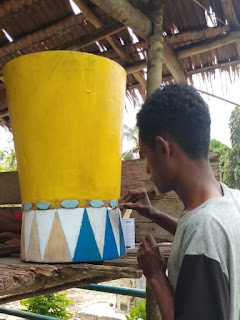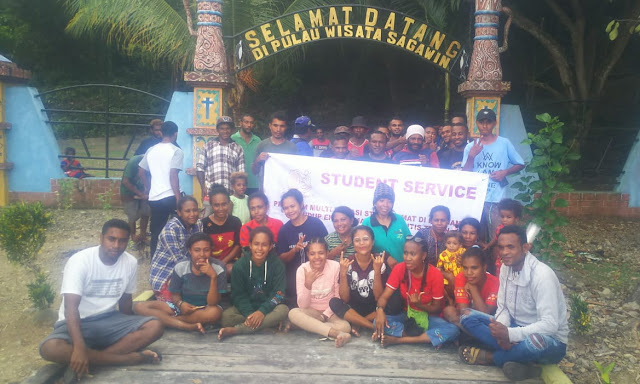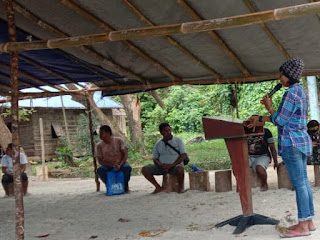The Youth of Yefman Island & Ecoprint Batik
Friday, 8 October 2021by Rev. Grace Nanuru, S.Th
By Rev. Grace Nanuru, S.Th
'Working Young People' became the theme of the training on Ecoprint batik. This spirit emerged from a slogan 'If not me, who ones else and if not now, when? This sentence motivated young generation to be braver to do something, to express creativity, and to be different. Motivation is the strength starting from one’s inner then encouraging others to work, especially increasing the resources of the young generation in Raja Ampat area.
Improving the quality of the young generation's resources is the main focus of the Multiplication program of Stube HEMAT in Raja Ampat through various activities, one of which is eco-print batik. This eco-print batik is a simple batik technique because the material comes from the environment or the surrounding nature. Eco-print itself comes from the word 'eco' or ecosystem which means biological or natural environment, and 'Print' means to print, print leaf patterns, and boil them, similar to the process of making traditional batik, so it is often called 'eco-print batik.' The materials used are leaves, flowers, and twigs that come from nature, without synthetic chemicals, which makes this batik environmentally friendly and does not cause water, soil, or air pollution because the dyeing process of the fabric uses natural materials. No less interesting, the participants of the training on eco-print batik were the young people of Yefman Island who were very excited to learn new things. Some women also joined and took part in practicing eco-print batik which was held in East Yefman village. The training itself was attended by eighteen participants (Thursday, 7/10/2021).
This activity has objectives: 1) to train the creativity of students and youth in East Yefman village; 2) students and youth learn to make motifs on fabrics using natural materials available around them and easily to get; 3) youth are aware to hone their creativity even during the pandemic by keeping the health protocols.
The Multiplicator of Stube HEMAT in Raja Ampat involved several students from Raja Ampat who have participated in previous Stube HEMAT activities so that they understand more about Stube HEMAT activities. Efata Yefman's youth assistant, Fera Karet, responded positively to this activity and will promote eco-printed fabrics on Sunday, October 10, and develop eco-print batik with Yefman's women community group with the multiplicator.
During the activity Rev. Grace Nanuru, the Multiplicator of Stube HEMAT in Raja Ampat asked the hopes of Yefman island youth after attending this training. It was revealed that they felt the benefits of the training and would do the follow-up on eco-print batik making and hoped that in the future, Stube HEMAT activities involved them, as expressed by Hilda Mnusefer. The multiplicator also explained the work camp activities that will be held on Sagawin island, October 25-28 2021. Meanwhile, student activists from Stube HEMAT in Raja Ampat who accompanied the multiplicator were interested in continuing this activity in Yenanas, their village, and conveying their experiences at Stube HEMAT to the participants, and the critical thoughts emerged of what can be done in the future for the development of the young generation of Raja Ampat's resources.
The big hope of the Multiplication program of Stube HEMAT in Raja Ampat is young generation of Raja Ampat will become young people that be able to build their area through working and developing creativity by utilizing the potencies around them. The young generation of Raja Ampat is the working youth, they can make it.
Tambur: building togetherness of life
Sunday, 8 August 2021by Stube HEMAT
By: Stube HEMAT
Tambur (drum) is an acoustic musical instrument usually used during traditional events such as welcoming guests coming to the village or when the government officials visit. This musical instrument is a typical musical instrument from Raja Ampat Regency and has been designated by the government as part of the annual Flute Tambur festival. This festival reveals the exotic sea of Raja Ampat and the strong influence of the traditional culture of Raja Ampat.
Starting on July 21, 2021, the youth of Kapatlap village, North Salawati district, began to work on this traditional drum instrument. This activity is one of the positive and productive efforts during the pandemic because the work related to the tourism sector has not yet been revived and can be said to be dead. The making of the instruments became a preparation for the Flute Tambur festival which will be held when the situation becomes conducive.
The initial process begins by selecting several large trees to be cut as the base material for the large-sized drum. After that, the drum logs were soaked in the river for almost two weeks. While waiting for the process of soaking, the youth of Kapatlap started hunting for Lao-Lao animals, a type of kangaroo, of which leather would use as drum covers. The hunting activity was done in Wayar forest for two days (29-30/07/2021), so it was necessary to stay in the beachfront forest using a practical tarpaulin tent. The Multiplicator of Stube HEMAT in Raja Ampat, Rev. Grace Eirene Nanuru was also involved in these activities to ensure that these actions did not damage animal habitats for the balance of the forest environment by hunting sufficiently, not an exploitation.
The work on making drums came to the third step (4/08/2021), namely lifted the drum logs from the river. After being lifted, the drum logs entered the process of scraping, trimming, motifs drawing, and painting. The last process is the sewing of the kangaroo leather on the drum, the process is carried out after the leather is completely dry.
After every step is done, there will be a parade or carnival of drums around the village as an expression of joy and to revive the sense of brotherhood as the people go out and dance together. Building a sense of togetherness is very important to unite the vision and mission of life in the future.
You care of me and I care of you: Healthy Generation, Excellent Raja Ampat
Thursday, 5 August 2021by Rev. Grace Nanuru
By: Rev. Grace Nanuru
The protracted Covid-19 pandemic requires cooperation from all parties to reduce the rate of virus infection and even jointly stop it. The Multiplication of Stube HEMAT in Raja Ampat together with students is called to participate in promoting healthy living and inviting the public for vaccines as an effort to grow active immunity in the body to prevent or reduce infections caused by viruses. As a pastor, the multiplicator also works in the spiritual aspect with a theme 'What does our faith say to maintain our immunity?
The activities carried out on August 3, 2021, are aimed at:
- Setting the foundation for the younger generation and students to be sensitive to social problems that occur in society, especially public health and the current pandemic.
- Students and youth as the driving force can help the public to get the correct information about vaccines and how the perspective of the Christian faith.
- People realize and commit to healthy living.
As a form of synergy, the activity collaborated and received good responses from the Head of the public health center and its medical team at Samate district, and the military command of Samate district. This is the first time for such a collaboration there which cover socialization of health programs by the Stube HEMAT Multiplicator with the theme 'Healthy Generation, Excellent Raja Ampat' with the Papuan colloquial slogan 'Ko Jaga Sa, Sa Jaga Ko', which means 'you care of me' and I take care of you'.
In this activity, the Head of the Public Health Center at Samate district, Mantri Frans Klasin, explained the pandemic situation and how to take care of ourselves, and why the vaccine is needed by the body. The activity started at 07.00 until 14:00 Eastern Indonesian Time, got along with the second stage of vaccination, and was attended by all residents of North Salawati and Central Salawati districts (Waipele, Kapatlap, Samate, Waidim, Waimicu, Warirsapo, Kalobo, Yefman, and Wajan).
The Multiplication of HEMAT in Raja Ampat carried out several activities, such as 1) Socialization of activities and directions from the Head of the Public Health Center, 2) Distribution of masks, 3) Distribution of vitamins, 4) Distribution of cakes when the community arrived at the vaccine site, and 5) Distribution of mung bean porridge, for participants who have been vaccinated while waiting for the results of observation for 30 minutes.
With the right treatment and approach, it is expected that the level of public awareness of health, especially to receive vaccinations during the Covid-19 pandemic, will increase.
Reaching The Young In Kalobo And Yefman
Tuesday, 22 June 2021by Trustha Rembaka.
(Multiplication program of Stube-HEMAT in Raja Ampat)
By: Trustha Rembaka.
Raja Ampat Regency consisting of 117 villages that spread out on several islands has an area of 46.108 km2. With a very wide coverage consisting of 89% of waters, the sea transportation becomes the main requirement for the mobility of people and goods from island to island. It is a challenge for the government to develop the area, as well as for the community to carry out activities such as to meet others, to do educational affairs, to have economy activity, and other needs, due to the high-cost transportation. Not giving up on the situation and let the area being left behind, all components endeavor to pay attention to the condition of the people there.
The Multiplication program of Stube HEMAT in Raja Ampat together with Christian students and young people are working to improve the quality of human resources even though these activities require a long process to achieve the noble goals of the program. It is reasonable for the Multiplicator to have continuous approaches to several villages to introduce Stube HEMAT by involving students from Raja Ampat who participated in several previous activities in North Salawati, Central Salawati, Batanta, and the capital of Raja Ampat district, Waisai. Rev. Grace Nanuru, S.Th., the Multiplicator of Stube HEMAT in Raja Ampat keep working to introduce Stube HEMAT and its programs, as well as delivers church youth programs including students. It must be admitted that there are several obstacles for the activities such as lack of motivation, budget priorities, and communication between regions, so it is important to have work priority for the region.
During May and June, the Multiplicator visited some villages by using a small boat and must carefully do 'mapping' the weather at the sea. One of the visits was to the village of Wailen, Kalobo in Central Salawati district. This village has more than five thousand people and the majority of the population is Muslim and most of them are transmigrants from Java island a long time ago. Geographically, this area has a wide and fertile plain so that agriculture has the potencies to be developed. There is only one church here, Indonesian Christian Church (GKI) in Papua. Yefman Island consisting of West and East Yefman with most of the population is Muslim and only a small part is Christian. The church youth, including students in both places, was accompanied by a chaperone from the church council. They responded enthusiastically about the attention and activities of Stube HEMAT and willing to involve in various activities that will be carried out in the following activity of the Multiplication program of Stube HEMAT in Raja Ampat.
Through the activity of Stube HEMAT, church youth, and students, it is expected that the human resources of the young generation of Raja Ampat will increase and be able to develop themselves with their surrounding potencies. Jou Suba***
Children of Islands Tell Stories
Monday, 22 March 2021by Rev. Eirene Grace Nanuru
Multiplication Program of Stube HEMAT in Raja Ampat
By: Rev. Eirene Grace Nanuru
Since Covid-19 hit parts of the world, including Indonesia, the eastern part of Indonesia has not been spared, including Raja Ampat Regency in West Papua. The geographical condition of Raja Ampat regency, which is mostly ocean and transportation is merely by the sea, greatly affects one's work activities, including teachers. During the Covid-19 pandemic, education in Raja Ampat is getting more worrying because the children cannot study properly, and sometimes teachers are not always available.
It is serious homework for the local government to organize the education system with limited teachers, geographical conditions, unequal internet network coverage for 117 villages in Raja Ampat regency, while, nobody knows when the pandemic will end. Are there any learning methods for children on the islands so that they can still learn even though they are not formally at the school? There must be a way to keep children motivated to learn, read, and count. Together with several students, the Multiplicator of Stube HEMAT in Raja Ampat tried a method “children of islands tell stories” in several villages.
In Waipele village in North Salawati district (12/03/2021). The local people were very enthusiastic about the activity, even parents with children were involved and accompanied their children, especially those who could not hold writing tools and coloring pictures and while coloring they tell the colored pictures. Mince Inseruy and Lenny Rumayom, the education students who were involved in the activity, felt happy to accompany the children of the Waipele village community. Children aged 2-4 grade of elementary school learned how to count and recognize letters, pronounced the alphabet in English, introduced themselves in English. This group was accompanied by Pdt. Grace Nanuru, the Multiplicator of Stube HEMAT in Raja Ampat. Meanwhile, the children in grades 5 and 6 of elementary school were given children's storybooks and allocated time to read. Then they retold the story accompanied by a Sunday School teacher. It turned out that the children were enthusiastic and confident in retelling what they had read.
The next trip is from Sorong to Weiman-Batanta (17/03/2021). Before going to Weiman, the group transited on Yenanas Island to pick up students. The journey took approximately 2 hours. Unexpectedly, there were 20 children from Yenanas who joined the journey to Weiman. The activities carried out are similar to activities in Waipele, but the activities at Weiman were held in 2 days, because there were additional activities such as story games (playing while telling stories), praying together, and exposure to waterfalls.
The activities are beneficial not only for children but also for the students, being trained to be sensitive to social problems that exist in the world of education. Hopefully, the activities will support the quality improvement of human resources in the Raja Ampat regency. Jo Suba! ***
What Can I Do in My Youth Age?
Monday, 15 February 2021by adminstube
(Raja Ampat in the global challenges)
Amid the rush of the global challenges, the students and youth of Raja Ampat were invited to prepare themselves by doing reflection (11-12/02/2021) while looking at the potency that exists around them, especially on Sagawin island, the administrative area of Kaliam village, West Salawati district, Batanta neighborhood, Raja Ampat regency.
Why is it on Sagawin Island? On this island, there is a 20-meter high statue of Jesus Blessing, which was officially opened on October 18, 2015, by the Minister of Home Affairs Tjahyo Kumolo. Unfortunately, until now this location has not received full attention from the local government or by the church classis. Even it seems abandoned, even though this place has extraordinary tourism potencies, it can be an asset for both the church and the local government of Raja Ampat regency. The location of the Jesus Blessing statue is an important site after Mansinam Island because it was built regarding the history of evangelism in Papua.
The activities on this island are specifically for students and church youth to get the motivation to do activities and to train sensitivity to care for the environment and also open up the insight of youth about Batanta environment with regional potencies to be developed especially to face global challenges. There are 33 youths from Kaliam village, 27 from Wailebet, 25 from Yenanas, 15 from Weiman, and 7 from Kapatlap, plus the people of Kaliam village. In this activity, the multiplicator coordinated with the head of Kaliam village and the local police in Wailebet village which is directly face-to-face with Sagawin island.
After the introduction about Stube HEMAT multiplication program in Raja Ampat, “What can I do when I am young?” became the main topic that blows youths' minds to face global challenges and competition. As a reflection igniter, the multiplicator was assisted by Rev. Theo Tumanserry, S.Th (Chairman of the Bethesda congregation of Wailebet) and the head of the Central Raja Ampat Youth Working Group. In addition to the discussions and sharing, a meditative service was also held on the 2nd floor at the foot of the Jesus statue.
The sea currents flew quite strong due to the wind in the early months of the year, but it did not stop the participants’ spirit for gathering and doing activities. This activity looked simple but gave a tremendous impact reaching students and young people to interact and think about themselves and the future. Happy process! ***












































